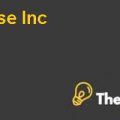
BUSSE PLACE
Introduction, Current Situation and Leasing Strategy:
Busse Place was a 95,372 square foot office building located next to northwest Tollyway. It had 202 rooms’ hotel, three retail buildings, fitness club and 500 dedicated parking spots. The building was landscaped with beautiful willow and beach trees in order to make its environment very attractive. The building was acquired by Collins Properties, who owned it with a view to improve its performance even further through their management expertise. At the time of acquisition, the building was 78% occupied out of which 43% of the property was leased by Saxon Mortgage. The property was acquired for a total price of $15.94 million including its acquisition related cost. The cost was financed by a Commercial Mortgage Backed Security (CMBS), which provided 80% of total acquisition amount and the remaining 20% was financed through equity out of which 10% and 90% of total equity amount was provided by Collins Properties and Douglas Private Equity Partners respectively.
With the passage of time, the Saxon Mortgage faced bankruptcy due to which it lost its major tenants from which a large proportion of revenue was derived. Soon with recession in place, the building’s occupancy reduced from 78% to 38% only.
So due to such a low vacancy rate, soon the organization started to suffer as it had to meet its debt payments along with other operating expenses, however, it was not possible to pay such huge expenses without earning sufficient cash flow from high occupancy rate.
Therefore, in order to fill up the vacancies, the organization had hired a top leasing agent by the name of Marisa Sanchez. She was required to search for the potential tenants, who would be willing to lease the area in the office building.
Recently, she was contacted by John Atcher, the CFO of Northwest Trust Company, who informed her about the current lease of Northwest being expired soon, due to which they were looking for a new place for relocation, as result of that, the Busse Place was in their list along with 1500 Higgins and Two Schaumburg Place. The area that they were looking to lease should be approximately 13000 square feet. In addition to that, the offer for a lease also came from Meineke & Book and Riggs Executive Search Group requiring 8000 and 3000 square feet respectively. All these offers required an attractive proposal; as the potential tenants were also considering other buildings for lease such as 1500 Higgins and Two Schaumburg Place.
Eventually, the proposals were made for each of the potential tenants, however; none of them had been accepted yet as they considered that rent rates were too high. Hence, in order to gain business she was required to prepare a second proposal, which was attractive enough to persuade the client in leasing the area of the office building.
The leasing strategy proposed to Fairchild should include the following tactics:
- First the rent should be competitive, which means it should not be too high that it would give the client to the competitor and also not too low, which would not allow the organization to cover its operating and financing expenses.
- The tenant improvement expense should be in line with the market rate, in order to compensate the client for any customization.
- The facilities and service provided by the management should be satisfying, as it was also as an important point to consider when searching for a place at rent.
- The terms of the lease should not include conditions, which might deter the client from making any deal.
- The free rent period provided should be competitive enough to compete with the custom in the market however; it should not be that much high, which would entail any losses.........................
This is just a sample partial case solution. Please place the order on the website to order your own originally done case solution.
Largest tenant Busse Corporate Center recently filed for bankruptcy, leaving the building to 38% of employment and a large surplus. In suppressing the suburban Chicago office, Marisa Sanchez, leasing agent must negotiate lease offer three potential tenants to try to fill the vacant seats. Meanwhile, the owner of the building, Collins properties to decide with its equity partner, whether to continue funding the loss of the building while trying to lease vacant space, a debt restructuring or default on the loan and convert the building to its creditors. A decision on the use of more complex Collins of commercial mortgage-backed Security (CMBS) loan, which involves several parties, ambiguous relationships, and bifurcated responsibilities. "Hide
by Arthur I Segel, William J. Poorvu, Justin Ginsburg, Richard Kessler Source: Harvard Business School 21 pages. Publication Date: June 18, 2009. Prod. #: 209154-PDF-ENG













